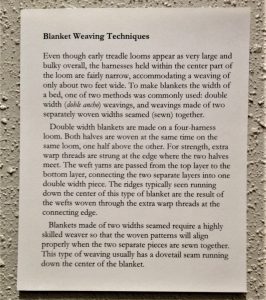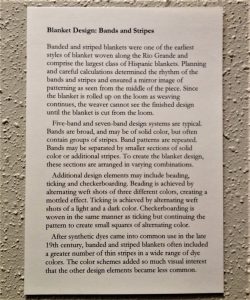 Interpretive labels provide visitors with information and the context: political, economic, societal, historical, and/or cultural, from which to view and better understand an exhibit. Accordingly, I developed a number of interpretive labels regarding key areas of interest, identified during my research into Rio Grande textiles. Blanket Weaving Techniques describes the two methods used to weave these textiles: double width and two widths seamed, both of which are represented in the displayed blankets.
Interpretive labels provide visitors with information and the context: political, economic, societal, historical, and/or cultural, from which to view and better understand an exhibit. Accordingly, I developed a number of interpretive labels regarding key areas of interest, identified during my research into Rio Grande textiles. Blanket Weaving Techniques describes the two methods used to weave these textiles: double width and two widths seamed, both of which are represented in the displayed blankets.
 Dyes: Natural and Synthetic discusses the dyestuffs used to create the wide palette of dyed wool colors used to weave the blankets and the historical discovery and introduction of synthetic dyes.
Dyes: Natural and Synthetic discusses the dyestuffs used to create the wide palette of dyed wool colors used to weave the blankets and the historical discovery and introduction of synthetic dyes.

Blanket Design: Bands and Stripes describes the patterns used in the vast majority of Rio Grande textiles and in each of the blankets on display.
 WPA Weaving Revival discusses the 1930s Works Progress Administration project in San Luis, Colorado at which the weaver of one of the displayed blankets learned his craft.
WPA Weaving Revival discusses the 1930s Works Progress Administration project in San Luis, Colorado at which the weaver of one of the displayed blankets learned his craft.
All four of these interpretive labels accompany the exhibited Rio Grande blankets, affixed to the walls in near proximity. Many visitors pause to read these labels and then return to the blankets for a closer look.
In addition to these, I developed several additional interpretive labels that are included in the visitor take-away sheet. Looms: Warps, Wefts, and Patterns describes the patterns common to looms that orient warps and wefts perpendicular to each other. Sheep and Wool discusses the original churro sheep introduced by the first Spanish settlers to the area and the mid-nineteenth century Anglo commercial introduction of Merino sheep whose unsuitable wool characteristics contaminated churro wool, leading to a loss of quality and contributing to the decline in traditional Hispanic weaving.
